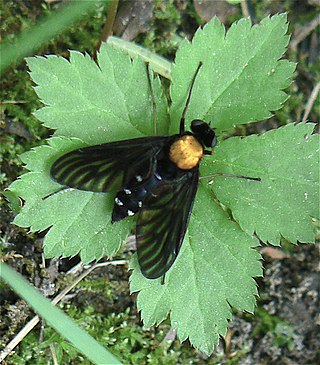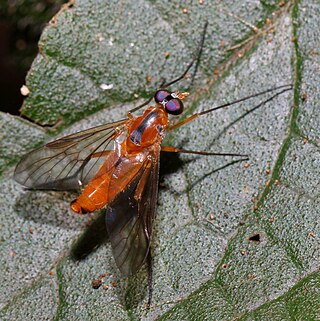
Francis Walker was an English entomologist. He was born in Southgate, London, on 31 July 1809 and died at Wanstead, England on 5 October 1874. He was one of the most prolific authors in entomology, and stirred controversy during his later life as his publications resulted in a huge number of junior synonyms. However, his assiduous work on the collections of the British Museum had great significance.

Chrysopilus is common, worldwide genus of predatory snipe flies. There are approximately 300 species in the genus, including fossil members that are sometimes found in amber.

Rhagionidae or snipe flies are a small family of flies. They get their name from the similarity of their often prominent proboscis that looks like the beak of a snipe.

Rhagio is a worldwide genus of predatory snipe flies. Several species in this genus are referred to as downlooker or down-looker flies because they sometimes perch on tree trunks in a head-down position. There are approximately 170 species. They can be distinguished from other rhagionids by the open anal cell on the wings and the lack of a kidney-shaped arista.

Athericidae is a small family of flies known as water snipe flies or ibis flies. They used to be placed in the family Rhagionidae, but were removed by Stuckenberg in 1973. They are now known to be more closely related to Tabanidae. Species of Athericidae are found worldwide.

Symphoromyia is a genus of predatory snipe flies. Unusually for Rhagionids, some species of Symphoromyia are known to feed on mammal blood, including human blood. Symphoromyia species are stout bodied flies from 4.5 to 9 mm and with a black, grey or gold thorax, and the abdomen is coloured grey, black, or both black and yellow, black terminating with yellow, to completely yellow. The wings are hyaline or lightly infuscate.

Ptiolina is a genus of snipe flies of the family Rhagionidae,. Examples are found in Northwest Europe, where it prefers woodlands areas. and North America

Dexia is a genus of flies in the family Tachinidae. Most larvae are parasitoids of beetles (Scarabaeidae).

Rachicerus is a genus of flies in the family Xylophagidae.

Atherix is a genus of 'ibis flies' belonging to the family Athericidae, a small family very similar to the Rhagionidae. Species within this genus are present in most of Europe and also in the Nearctic realm.

Ptiolina obscura is a species of 'snipe flies' belonging to the family Rhagionidae.

Dialysis is a genus of flies in the family Xylophagidae.

Chrysopilus fasciatus is a species of snipe fly in the family Rhagionidae.

Tabanus trimaculatus is a species of horse fly in the family Tabanidae.

Rachicerus fulvicollis is a species of fly in the family Xylophagidae.

Chrysopilus basilaris is a species of snipe fly in the family Rhagionidae.
Antissinae is a subfamily of soldier flies in the family Stratiomyidae.
Chrysopilus proximus is a species of snipe fly in the family Rhagionidae.

Suragina is a genus of flies in the family Athericidae.
Odontomyia ialemus is a species of soldier fly in the family Stratiomyidae.


















